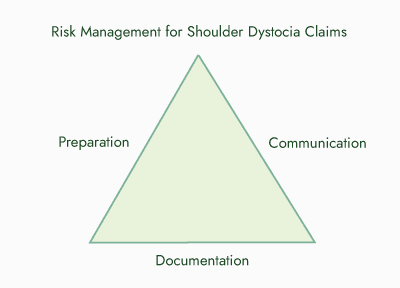Shoulder dystocia is a relatively uncommon birthing complication that occurs when one or both of a baby’s shoulders get stuck in the birthing parent’s pelvis during labor. Despite its relatively low rate of occurrence — and the fact that a majority of babies in these cases are born safely — shoulder dystocia is still a leading cause of litigation in obstetrics. In this article, we’ll look at an important topic for obstetric providers and clinicians: risk management for shoulder dystocia claims.
Shoulder dystocia is typically diagnosed when there is a failure to deliver the fetal shoulders with gentle downward traction on the fetal head and delivery requires additional obstetric maneuvers, according to the American College of Obstetricians and Gynecologists (ACOG).
There are known risk factors for shoulder dystocia, but ACOG advises that it is neither predictable nor preventable. Although heavier babies and parents’ preexisting conditions (such as diabetes) are risk factors, studies have shown that these risk factors cannot predict shoulder dystocia. The risk in a second delivery can be higher, but a previous incidence of shoulder dystocia does not guarantee a recurrence.
Essential components of risk management for shoulder dystocia claims
A well-educated and prepared obstetric team is the best defense against harm — and lawsuits. All clinicians should:
- Be knowledgeable about shoulder dystocia
- Understand why and how it can happen
- Be prepared to manage this medical emergency
- Ensure that the medical record accurately reflects what occurred
In addition, those providing care must know how to work as a team, including optimizing communication among team members and with the patient and family.
Because complications of shoulder dystocia can lead to lawsuits and can occur even with the best care, it is important for every member of a healthcare team to be well-trained in shoulder dystocia practice protocols. Proactive risk management for shoulder dystocia claims through thorough documentation is one of the best forms of protection to minimize liability.

Unfortunately, despite the relative infrequency of shoulder dystocia, these cases can result in some of the costliest lawsuits caused by birthing complications. Forbes Advisor lists possible legal actions for shoulder dystocia that can occur if a patient or patient’s family believes their labor and delivery were mismanaged and alleges medical mistakes or negligence.
Complications of shoulder dystocia
Brachial plexus injury (BPI) occurs in 2.3-16.0% of shoulder dystocia cases and is the most common shoulder dystocia complication for infants. BPI is the result of damage to the brachial plexus nerves — nerves that run from the spinal cord and down into the arm — that can lead to weakness or paralysis in the shoulder or arm. Although it is typically associated with shoulder dystocia, BPI also occurs in deliveries where shoulder dystocia is not a factor, such as with a precipitous delivery.
Other possible fetal complications of shoulder dystocia include fractures of the fetal clavicle and humerus and, in rare cases, asphyxia (a lack of oxygen in the body that can lead to brain injury or death). Fortunately, death is extremely rare and is reported in only 0.4% of cases.
For birthing parents, risk factors include tearing of the perineum (the area between the vagina and the rectum), postpartum hemorrhage, and uterine rupture.
While the severity of complications varies, most parents and infants recover from shoulder dystocia with an appropriate course of action, which may involve one or more of a series of shoulder dystocia maneuvers developed and refined by providers.
Documentation improves risk management for shoulder dystocia claims
With the risk of litigation and the variability in shoulder dystocia treatment, it is vital to document in detail every technique and procedure used. Implementing a comprehensive checklist for shoulder dystocia documentation can help protect medical personnel from litigation.
The Doctor’s Company, a medical malpractice organization, recommends the use of a standardized tool for shoulder dystocia that prompts providers to incorporate specific information when documenting the delivery, such as pertinent patient history and risk factors. All reports should be completed promptly and with enough detail and clarity that anyone — whether a medical professional or a courtroom attendee — can understand them.

More articles in this series
What should be documented?
An exhaustive shoulder dystocia report should include:
- Time and method of diagnosis, as well as the position of the baby’s head upon diagnosis.
- All healthcare professionals attending the delivery, including doctors, nurses, and any other personnel (anesthesiologists, pediatric clinicians, etc.) who were called in to assist.
- Details on all the procedures, instruments, and maneuvers employed, the order in which they were employed, the result obtained from each, and the reasons they were used.
- Include either the actual or estimated times between the initiation of each maneuver and the initiation of each subsequent maneuver. This is considered the “action plan” and is one of the most important elements to document.
- The time of delivery of the head.
- The time between diagnosis and delivery.
- Impressions of the newborn upon delivery, including Apgar scores, birth weight, and the presence or absence of a nuchal cord, meconium staining, or intrapartum injury. It’s also important to include details about the placenta.
- A formal newborn assessment, including noting pulses, affected arm weaknesses, and reflexes.
- Any requests made to the pediatrician or neonatologist to check the newborn’s clavicle, humerus, shoulder, etc.
- Notes on the birthing parent’s condition immediately following delivery, including all relevant findings of the postpartum exam and any actions taken on behalf of their well-being, such as blood transfusions or pain relief measures.
- Documentation that the birthing parent was informed of the occurrence of shoulder dystocia and the potential sequelae. The report must also state that they were given time to ask questions and express their concerns. A detailed list of those questions, concerns, or requests should be included.
Keep patients and practitioners safe
Shoulder dystocia is a challenging medical emergency that is unpredictable and unpreventable. It is a delivery presentation that affects birthing parents and infants across the globe. It is also a leading cause of litigation in obstetrics. High-quality team training on identification, management, treatment, and documentation provides effective risk management for shoulder dystocia claims. And with the right training, quality of care increases, delivery risks decrease, and healthcare teams and systems are better protected.
Relias provides OB training and education for obstetric providers and clinicians. Our in-depth education on shoulder dystocia treatment and documentation provides protection for patients, practitioners, and healthcare organizations. Together, we can work to improve and support quality obstetric care, high reliability, and better patient outcomes.

Maternal Mortality Toolkit
Obstetrical hemorrhage, unmanaged hypertensive disorders in pregnancy, and unnecessary C-sections cause maternal death and harm, often as the result of clinical practice variation. Relias has developed a resource kit with information on education and best practices that can help.
Access the toolkit →





